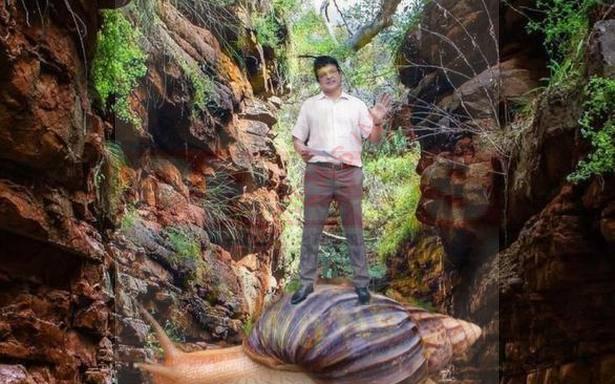People are resorting to unique activities like snail catching competitions to fight the Giant African Snails, which damage crops, plants and even concrete structures
The march of the Giant African Snail (GSA) has left people hapless. They are now devising fun activities to counter the menace.
On August 15, the All-India Anglo-Indian Association of Fort Cochin held a competition to catch the maximum number of Giant African Snails in one hour.
“We wanted to celebrate Independence Day in a uniquemanner. This was a fun activity but the underlying message is serious. It’s time we treat the GSA as a serious threat to local environment,” says Ian D’Cruz, member of the organisation.
Twenty participants, mostly children, caught 30 kilograms of slugs from Beach Road in Fort Kochi. The catch was sprayed with common salt and buried in a pit.
“That is the most effective, easy and common solution,” explains D’Cruz who gave a talk on awareness regarding the snails.
How it reached Kerala
The origin of the snails in Kerala goes back 25 years ago when it was brought from Singapore for research to Palakkad, but the research project failed to take off.
KV Sajeev, Senior Principal Scientist at KFRI (Kerala Forest Research Institute), at Peechi, Thrissur, who heads its Nodal Centre for Biological Invasion says that the research snails were disposed off properly and these snails came through timber imports from Myanmar. He was the first to map their outbreaks in Kerala.
“In 2018 before the floods, there were 223 outbreaks in the entire State but after that and the pandemic the situation has been haphazard and no proper protocol on ways to manage this menace has been undertaken,” says Sajeev.
He speaks of the competitions as crossing a threshold, when people are forced to act regarding an invasive species, whether it be a plant or animal.
Jacob Varghese, Professor of Botany at Bharat Mata College and actively involved in organising flower shows in Kochi talks about the threat from these creatures to not only plants and flowers but also to trees and walls.
The GSA’s requirement for calcium is high and the reason why it is found on walls, says Sajeev.
Slug in the bedroom
Jacob narrates a recent incident of a man from Aluva who approached him with a problem regarding his three-year-old jackfruit and mango trees that were fruiting healthy and lush but of late had their leaves wilting. “I asked him to check for GSA, which comes out at night and sure enough he found that the slugs were eating into the bark and destroying the tree itself,” says Jacob. He laughs when he talks about the snails climbing up two-storied houses and being found in his friend’s bedroom wall.
Unlike regular small slugs which remain confined to a garden plot or to an area, the GSA can travel long distances and hence infest a larger region.
“Except for the hilly districts of Idukki and Wayanad, all other 12 districts of Kerala have been invaded by them,” says Sajeev adding that a decoction of tobacco and copper sulphate is a satisfactory treatment.
Jacob says that chemical fumigation from “snail pellets” used to bring out small snails from bushes and undergrowth but is not so effective in the case of GSA. “These hide during the day and come out at night time,” he says.
Priya Kaladharan recalls her night vigils when she along with her sons, wearing gum boots and armed with flash lights would locate the snails from her vegetable patch and spray them with salt. “We do that on a regular basis and find it the only way to control them.”
Other methods that Priya has tried are using papaya leaves as bait and drawing them to it. “The slugs love papaya leaves,” she says. Once in a way she surrounds her bed of vegetables with papaya leaves.
Home remedies
“Spraying salt does destroy the slugs but it is followed by quick rotting. Another local method is by digging a hole and filling it with jaggery powder, coconut water and cabbage leaves. Slugs are attracted by the smell of coconut water and they feed on cabbage leaves. Once they are at the pit it is easy to destroy them,” says Jacob. He also points to the more serious concern of the snails being the cause of health problems, like meningitis, especially in children.
Meanwhile another recent activity, (August 1-5) , “a snail free village” at Ward 12, Public Welfare Ward of Muhamma Gram Panchayat in Alappuzha is drawing applause. Here snail catchers were incentivised to win the State Government’s Thiruvonam Bumper lottery, the first prize being ₹12 crore, for the largest catch. It drew a huge response with 50 families joining in. Launched in June the year-long campaign will have snail catching events every alternate month. The next is scheduled for the first week of October.

